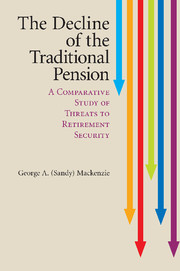Book contents
- Frontmatter
- Contents
- List of Tables
- List of Figures
- List of Boxes
- Acknowledgments
- Introduction
- PART ONE
- 1 The Development of Employer-Provided Pensions
- 2 The Economics of Employer-Provided Pension Plans
- 3 Issues in Funding and Investing
- 4 Current Regulatory Issues
- 5 Public-Sector Employer-Provided Pensions and Recent Innovations in the First Tier
- PART TWO
- Appendix 1 Ten Country Profiles
- Appendix 2 Mathematical Treatments and Derivations
- Glossary
- References
- Index
5 - Public-Sector Employer-Provided Pensions and Recent Innovations in the First Tier
Published online by Cambridge University Press: 05 June 2012
- Frontmatter
- Contents
- List of Tables
- List of Figures
- List of Boxes
- Acknowledgments
- Introduction
- PART ONE
- 1 The Development of Employer-Provided Pensions
- 2 The Economics of Employer-Provided Pension Plans
- 3 Issues in Funding and Investing
- 4 Current Regulatory Issues
- 5 Public-Sector Employer-Provided Pensions and Recent Innovations in the First Tier
- PART TWO
- Appendix 1 Ten Country Profiles
- Appendix 2 Mathematical Treatments and Derivations
- Glossary
- References
- Index
Summary
This chapter has two parts which address two different issues. The first part is concerned with public-sector employer-provided pension plans, and with a number of specific issues that these plans raise. The second part appraises some recent innovations in the design of public-pension (first-tier) plans. Both employer-provided public-sector plans and first-tier plans are financed by the taxpayer, and both are affected by population aging. Because most second-tier public-sector plans are funded, demographic change affects them differently than it does first-tier plans.
Public-Sector Pensions – Introduction
The pensions that public-sector employers – national and subnational governments, public utilities, and public enterprises – provide their employees deserve a prominent place in a study of the decline of the traditional pension. In most industrial countries, coverage of civil servants and other public-sector employees is near universal. In seven of the ten survey countries, public-sector pensions are either overwhelmingly or exclusively defined benefit.
The combination of the sizeable share of civil servants in the labor force and the predominant role of the traditional pension plan in the public sector means that enrollment in public-sector plans accounts for much of the coverage of the traditional plan in the Anglo-Saxon countries. This is particularly true of the United Kingdom, where public-sector employees account for more than 80 percent of the membership of open plans. Even in the United States, where general government is smaller in relation to gross domestic product (GDP) than it is in the other industrial economies, active members of state and local government pension plans represent about 10 percent of the labor force, which means that more than one in two traditional pension plan members are in the public sector.
- Type
- Chapter
- Information
- The Decline of the Traditional PensionA Comparative Study of Threats to Retirement Security, pp. 115 - 136Publisher: Cambridge University PressPrint publication year: 2010



